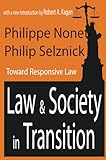Law & society in transition : toward responsive law / Philippe Nonet, Philip Selznick ; with a new introduction by Robert A. Kagan.
Publication details: New Brunswick, N.J. : Transaction Publishers, c2001.Description: xxviii, 122 p. ; 23 cmISBN:- 0765806428 (pbk. : alk. paper)
- Law and society in transition
- 340.115
| Item type | Current library | Shelving location | Call number | Materials specified | Status | Notes | Barcode | |
|---|---|---|---|---|---|---|---|---|
 BOOKs
BOOKs
|
National Law School | General Stacks | 340.115 NON (Browse shelf(Opens below)) | PB | Available | Recommended by Prof. Dr. Arun Thiruvengadam | 39077 |
Originally published: 1st ed. New York : Harper & Row, c1978. With new introd.
Includes bibliographical references and index.
Contents:
INTRODUCTION TO THE TRANSACTION EDITION vii;
PREFACE xxvii;
I Jurisprudence and Social Science 1;
Legal theory and the crisis of authority 4;
A social-science strategy 8;
A developmental model 18;
II Repressive Law 29;
Repression and the economy of power 33;
The official perspective 39;
The apparatus of coercion 42;
Dual law and class justice 44;
Legal moralism and punitive law 46;
III Autonomous Law 53;
Legitimacy and autonomy 55;
The separation of law and politics 57;
Legal formalism and the model of rules 60;
Procedure and self-restraint 66;
The claim to obedience 68;
Legal criticism and legal development 70;
IV Responsive Law 73;
The sovereignty of purpose 78;
Legal and political participation 95;
From fairness to competence 104;
Epilogue: Two Ways Law Can Die 115;
Index 119.
Year by year, law seems to penetrate ever larger realms of social, political, and economic life, generating both praise and blame. Nonet and Selznick's Law and Society in Transition explains in accessible language the primary forms of law as a social, political, and normative phenomenon. They illustrate with great clarity the fundamental difference between repressive law, riddled with raw conflict and the accommodation of special interests, and responsive law, the reasoned effort to realize an ideal of polity. To make jurisprudence relevant, legal, political, and social theory must be reintegrated. As a step in this direction, Nonet and Selznick attempt to recast jurisprudential issues in a social science perspective. They construct a valuable framework for analyzing and assessing the worth of alternative modes of legal ordering. The volume's most enduring contribution is the authors' typology-repressive, autonomous, and responsive law. This typology of law is original and especially useful because it incorporates both political and jurisprudential aspects of law and speaks directly to contemporary struggles over the proper place of law in democratic governance. In his new introduction, Robert A. Kagan recasts this classic text for the contemporary world. He sees a world of responsive law in which legal institutions-courts, regulatory agencies, alternative dispute resolution bodies, police departments-are periodically studied and redesigned to improve their ability to fulfill public expectations. Schools, business corporations, and governmental bureaucracies are more fully pervaded by legal values. Law and Society in Transition describes ways in which law changes and develops. It is an inspiring vision of a politically responsive form of governance, of special interest to those in sociology, law, philosophy, and politics.
There are no comments on this title.
